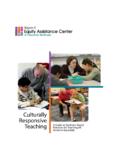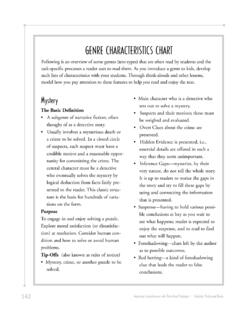Transcription of BEST PRACTICES IN ENGAGING DIVERSE FAMILIES
1 In the following report, Hanover Research examines literature and case studies on ENGAGING DIVERSE FAMILIES in public, K12 settings. It focuses in particular on the experiences and needs of large, urban public school districts, and on the experiences and needs of African-American and Hispanic FAMILIES . best PRACTICES IN ENGAGING DIVERSE FAMILIES May 2016 Hanover Research | May 2016 2016 Hanover Research 2 TABLE OF CONTENTS Executive Summary and Key Findings .. 3 INTRODUCTION .. 3 KEY FINDINGS .. 3 Section I: ENGAGING DIVERSE FAMILIES .. 5 GENERAL STRATEGIES FOR ENGAGING DIVERSE FAMILIES .. 5 Promote and Develop Cultural Competency .. 10 Hire DIVERSE Staff.
2 15 Choose or Develop Culturally-Relevant Programming .. 16 Meet FAMILIES Where They Are .. 19 Reach Out First .. 21 ENGAGING AFRICAN-AMERICAN FAMILIES .. 21 ENGAGING HISPANIC-AMERICAN FAMILIES .. 23 Section II: Case Studies .. 27 WASHOE COUNTY SCHOOL DISTRICT .. 27 SOUTH BEND COMMUNITY SCHOOL CORPORATION .. 32 Hanover Research | May 2016 2016 Hanover Research 3 EXECUTIVE SUMMARY AND KEY FINDINGS INTRODUCTION Family engagement, long a concern of public K12 school districts, has gained higher priority in recent years due to both research and policy efforts. Education reporter Karla Scoon Reid (2015) notes several ways school districts have evolved this practice, including developing positions and departments specifically geared toward parent involvement, with a concurrent growth in related organizations, increased attendance at conferences, and a heightened interest from some philanthropic groups to fund parent-engagement efforts.
3 1 This report examines literature and case studies on ENGAGING DIVERSE FAMILIES in public, K12 settings. It focuses in particular on the experiences and needs of large, urban public school districts, and on the experiences and needs of African-American and Hispanic FAMILIES . The report is organized as follows: Section I: ENGAGING DIVERSE FAMILIES addresses PRACTICES for ENGAGING DIVERSE FAMILIES . It outlines general best PRACTICES , then explores specific strategies for African-American and Hispanic FAMILIES , respectively. Section II: Case Studies presents two case studies of districts recognized for their service to DIVERSE populations. Below we present key findings from this research. Please note that throughout the report, we navigate disparate terminology for selected subgroups.
4 The terms Black and African American are used interchangeably to accommodate variations across the literature. Similarly, the terms Latina/o and Hispanic are used interchangeably, although we recognize that there are important distinctions that can be made among each of these four racial and ethnic categorizations. KEY FINDINGS Effective engagement of DIVERSE FAMILIES begins with understanding the local structural, attitudinal, and cultural barriers to their participation. Districts can use research generalizing the experiences of particular groups to help initial decision-making, but should not operate without input from the local community. FAMILIES may be unable to engage due to work expectations, transportation or childcare considerations, or other logistical factors.
5 However, the may also feel disconnected from or distrustful of the educational system. Additionally, local groups may represent unique combinations of cultures and backgrounds that broad categories like Black or Hispanic mask. Understanding local needs helps districts choose appropriate engagement strategies. 1 Reid, Parent Engagement on Rise as Priority for Schools, Districts. Education Week. June 2, 2015. Hanover Research | May 2016 2016 Hanover Research 4 Educators must build cultural competency at both systemic and individual levels, so that all FAMILIES feel welcome in all events and engagement opportunities. Staff training in parent engagement as well as in topics of diversity is essential to support these activities.
6 All staff must be welcoming, accessible, and available to minimize barriers to family participation. Effective districts seek to encourage DIVERSE FAMILIES participation in general as well as in targeted involvement opportunities. This might require the use of translators or community facilitators at common meetings, social gatherings, or conference nights. Districts can also offer community-specific opportunities such as diversity task forces, racial/ethnic group or disability advocacy or representational units, or targeted programming that supplements general opportunities. Home visits and other programs that take place outside the school build trust and cultural competency. Trained teachers visit FAMILIES at their homes or in community settings to construct shared meaning and a vision for their child s education.
7 Through this exchange, teachers gain insight into the educational and emotional values of that family and thus how best to support their child. Research suggests other options for this type of outreach, such as networking with churches, trusted community organizations, or neighborhood libraries and sites. However, FAMILIES may struggle with the logistical demands of programming outside of their home, or lack trust in a group setting. FAMILIES often need basic information about the education system. Certain populations, in particular immigrant populations and those facing linguistic barriers as well as FAMILIES of students with disabilities, may need more information about how the education system works in order to advocate effectively for their children.
8 Districts can begin the school year with information nights and related communications that provide this background knowledge before expecting parents to use services or network with staff. Parent universities, workshops, and related programming throughout the year can further help FAMILIES navigate the complexities of school partnerships, career and college planning, and disability or supplemental services. Districts should choose, build, or adapt programs to fit the cultural context of their communities. Initial program selection should consider the cultural values and needs of the school community, and promotions should frame participation in culturally- and linguistically-relevant terms.
9 These programs can be further adapted in small and large ways to further tailor the offering. This might include modification of program modules, creating or dropping modules, or adjusting the language to better reflect the diversity of the school. Hanover Research | May 2016 2016 Hanover Research 5 SECTION I: ENGAGING DIVERSE FAMILIES This section addresses PRACTICES for ENGAGING DIVERSE FAMILIES . It outlines general best PRACTICES , then explores specific strategies for African-American and Hispanic FAMILIES , respectively. GENERAL STRATEGIES FOR ENGAGING DIVERSE FAMILIES ENGAGING DIVERSE FAMILIES begins with acknowledging the need to engage all FAMILIES . The active support of community and family is essential to school reform, and such collaboration can ease the cultural dissonance that arises between a student population that is becoming increasingly DIVERSE and teachers who remain predominantly White and middle class.
10 2 The broad effects of family engagement on student outcomes is clear and well-studied. Matthew Kraft and Shaun Dougherty, for example, demonstrate that teacher -family communication helps increase the likelihood of students completing homework, paying attention in class, and participating in class. Communication with parents contributes to stronger teacher -student relationships and student It can be essential to school However, DIVERSE FAMILIES face significant barriers to Using data from the Early Childhood Longitudinal Study-Kindergarten Cohort (ECLS-K), Kristin Turney and Grace Kao explored the correlates of family engagement with attention to race and immigrant They found that black and Latino immigrant parents perceived a greater number of barriers ( , inconvenient meeting times, lack of transportation, not feeling welcome at their child s school, problems with safety in getting to school)


